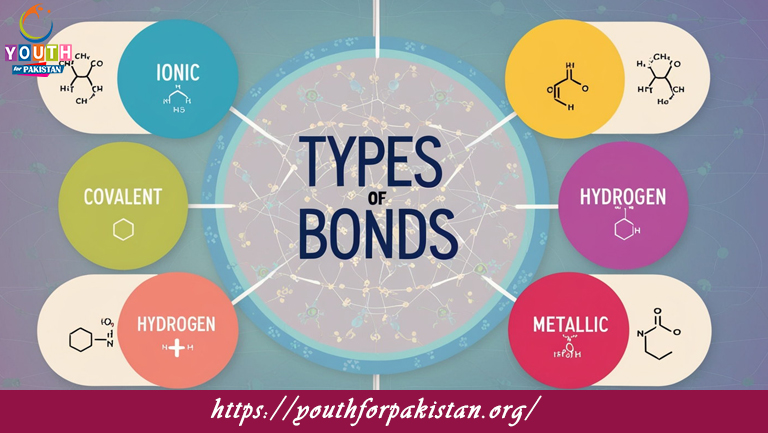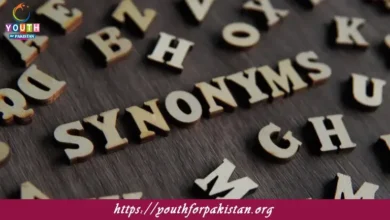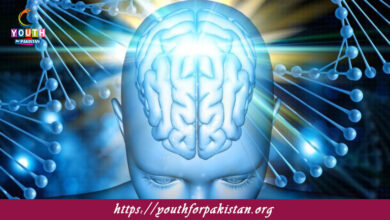Types Of Bonds MDCAT MCQs with Answers

Welcome to the Types Of Bonds MDCAT MCQs with Answers. In this post, we have shared Types Of Bonds Multiple Choice Questions and Answers for PMC MDCAT 2024. Each question in MDCAT Chemistry offers a chance to enhance your knowledge regarding Types Of Bonds MCQs in this MDCAT Online Test.
A bond formed by the sharing of two pairs of electrons between two atoms is called:
a) Single bond
b) Double bond
c) Triple bond
d) Quadruple bond
The type of bond that involves the transfer of electrons from one atom to another is known as:
a) Covalent bond
b) Ionic bond
c) Metallic bond
d) Hydrogen bond
Which type of bond is characterized by a “sea of electrons” that are free to move around the lattice?
a) Covalent bond
b) Ionic bond
c) Metallic bond
d) Hydrogen bond
The bond formed by the overlapping of s orbitals is called:
a) Sigma bond
b) Pi bond
c) Delta bond
d) Phi bond
The bond found in ethene (C₂H₄) is:
a) Single covalent bond
b) Double covalent bond
c) Triple covalent bond
d) Ionic bond
In a water molecule (H₂O), the type of bond between the hydrogen and oxygen atoms is:
a) Ionic bond
b) Covalent bond
c) Metallic bond
d) Hydrogen bond
The bond formed between hydrogen and oxygen in water is:
a) Sigma bond
b) Pi bond
c) Ionic bond
d) Hydrogen bond
Which type of bond involves the sharing of electrons but with unequal sharing, creating a dipole?
a) Nonpolar covalent bond
b) Polar covalent bond
c) Ionic bond
d) Metallic bond
The bond between the carbon and hydrogen atoms in methane (CH₄) is:
a) Ionic bond
b) Covalent bond
c) Metallic bond
d) Hydrogen bond
A bond in which electrons are shared equally between two atoms is called:
a) Polar covalent bond
b) Nonpolar covalent bond
c) Ionic bond
d) Metallic bond
The type of bond that is responsible for the high melting and boiling points of metals is:
a) Covalent bond
b) Ionic bond
c) Metallic bond
d) Hydrogen bond
In a molecule of nitrogen (N₂), the bond order is:
a) 1
b) 2
c) 3
d) 4
The bond that forms between a metal and a nonmetal is typically:
a) Covalent bond
b) Ionic bond
c) Metallic bond
d) Hydrogen bond
The bond formed by the overlapping of p orbitals side by side is called:
a) Sigma bond
b) Pi bond
c) Delta bond
d) Phi bond
The bond that holds the two hydrogen atoms together in a hydrogen molecule (H₂) is:
a) Ionic bond
b) Covalent bond
c) Metallic bond
d) Hydrogen bond
Which of the following bonds is the strongest?
a) Single covalent bond
b) Double covalent bond
c) Triple covalent bond
d) Ionic bond
The bond in which one atom provides both electrons for the bond formation is called:
a) Covalent bond
b) Ionic bond
c) Metallic bond
d) Coordinate (dative) covalent bond
In a molecule with a polar covalent bond, the atom with higher electronegativity:
a) Becomes positively charged
b) Becomes negatively charged
c) Shares electrons equally
d) Forms a nonpolar bond
Which type of bond is involved in holding the sodium and chloride ions together in NaCl?
a) Covalent bond
b) Ionic bond
c) Metallic bond
d) Hydrogen bond
In which of the following bonds does one atom donate both electrons to the bond?
a) Sigma bond
b) Pi bond
c) Coordinate covalent bond
d) Ionic bond
Which of the following compounds exhibits hydrogen bonding?
a) H₂O
b) NaCl
c) CO₂
d) CH₄
The bond present in a molecule of ozone (O₃) is:
a) Single covalent bond
b) Double covalent bond
c) Triple covalent bond
d) Resonance bond
The bond type that is generally found between two metals is:
a) Covalent bond
b) Ionic bond
c) Metallic bond
d) Hydrogen bond
The bond found in nitrogen trifluoride (NF₃) is:
a) Single covalent bond
b) Double covalent bond
c) Triple covalent bond
d) Ionic bond
The force of attraction between the hydrogen atom of one molecule and the oxygen atom of another molecule is called:
a) Covalent bond
b) Ionic bond
c) Metallic bond
d) Hydrogen bond
The bond in carbon dioxide (CO₂) is:
a) Single covalent bond
b) Double covalent bond
c) Triple covalent bond
d) Ionic bond
The bond in which electrons are delocalized and shared over many atoms is known as:
a) Sigma bond
b) Pi bond
c) Metallic bond
d) Hydrogen bond
In a molecule of ammonia (NH₃), the type of bond present is:
a) Ionic bond
b) Covalent bond
c) Metallic bond
d) Hydrogen bond
The type of bond formed between hydrogen and nitrogen in ammonia (NH₃) is:
a) Ionic bond
b) Covalent bond
c) Metallic bond
d) Hydrogen bond
The bond in which atoms have the same electronegativity and share electrons equally is called:
a) Polar covalent bond
b) Nonpolar covalent bond
c) Ionic bond
d) Metallic bond
The bond that is formed by the head-on overlapping of orbitals is:
a) Pi bond
b) Sigma bond
c) Delta bond
d) Phi bond
The bond in which two atoms share three pairs of electrons is:
a) Single covalent bond
b) Double covalent bond
c) Triple covalent bond
d) Ionic bond
In which of the following compounds is a coordinate (dative) bond present?
a) H₂O
b) NH₃
c) CO₂
d) NH₄⁺
The bond type that results from the electrostatic attraction between positively and negatively charged ions is:
a) Covalent bond
b) Ionic bond
c) Metallic bond
d) Hydrogen bond
The bond found in acetylene (C₂H₂) is:
a) Single covalent bond
b) Double covalent bond
c) Triple covalent bond
d) Ionic bond
Which of the following bonds is weakest?
a) Sigma bond
b) Pi bond
c) Ionic bond
d) Hydrogen bond
The bond between oxygen atoms in O₂ is:
a) Single covalent bond
b) Double covalent bond
c) Triple covalent bond
d) Hydrogen bond
The type of bond where atoms are held together by the mutual attraction of electrons and a positively charged nucleus is:
a) Covalent bond
b) Ionic bond
c) Metallic bond
d) Hydrogen bond
The bond in sodium chloride (NaCl) is:
a) Covalent bond
b) Ionic bond
c) Metallic bond
d) Hydrogen bond
The type of bond found in a salt crystal like NaCl is:
a) Covalent bond
b) Ionic bond
c) Metallic bond
d) Hydrogen bond
If you are interested to enhance your knowledge regarding Physics, Chemistry, Computer, and Biology please click on the link of each category, you will be redirected to dedicated website for each category.




